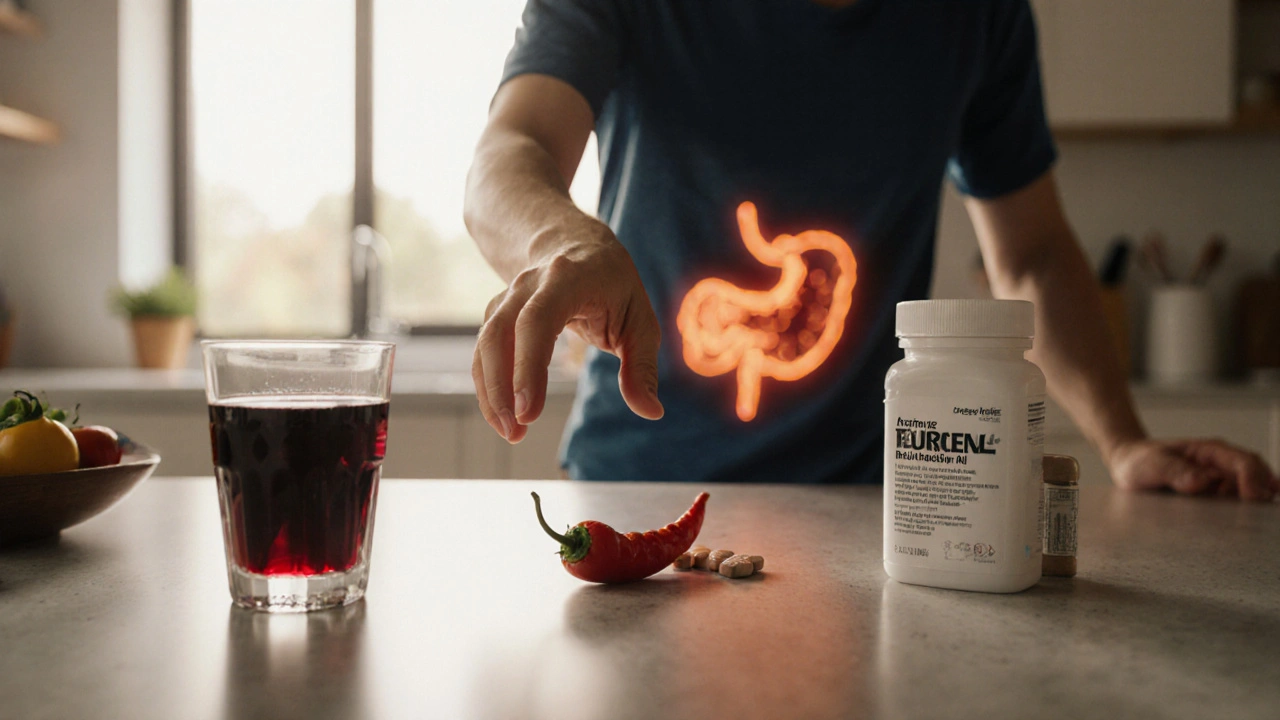8 Oct 2025
- 10 Comments
Natural Stomach Pain Relief Calculator
Your Personalized Relief Plan
Key Takeaways
- Identify and avoid common triggers such as spicy foods, alcohol, and NSAIDs.
- Boost gut health with fiber‑rich foods and daily probiotics.
- Use ginger, peppermint oil, or chamomile tea at the first sign of pain for quick relief.
- Manage stress through breathing exercises, yoga, or short walks.
- Seek medical help if pain lasts more than 24hours, is accompanied by fever, vomiting, or blood.
Understanding Severe Stomach Pain
When you feel Severe stomach pain is a sharp, intense discomfort in the abdominal area that can signal serious conditions such as gastritis, peptic ulcers, or gallbladder disease. It’s different from occasional cramps; the pain is usually persistent, localized, and can worsen after meals.
Typical causes include:
- Inflammation of the stomach lining (Gastritis is an irritation often triggered by alcohol, certain meds, or H. pylori infection.)
- Open sores in the stomach or upper intestine (Peptic ulcer can bleed and cause burning pain.)
- Digestive disorders like Irritable bowel syndrome (IBS), which creates cramping after stress or food.
- Gallstones or bile‑duct blockages that press against the stomach.
Knowing the root cause helps you choose the right natural approach.

Natural Prevention Strategies
Preventing pain starts with a gut‑friendly lifestyle.
- Boost fiber intake: Aim for 25‑30g of soluble fiber daily (oats, beans, apples). Fiber Fiber feeds good bacteria, reduces inflammation, and keeps digestion regular.
- Include a daily Probiotic supplement or fermented foods (yogurt, kefir, sauerkraut) to maintain a balanced microbiome.
- Limit caffeine, carbonated drinks, and highly processed snacks that can irritate the stomach lining.
- Stay hydrated - 2L of water a day dilutes stomach acid and helps food move smoothly.
- Practice Stress management techniques such as deep‑breathing, meditation, or short walks; chronic stress raises cortisol, which can increase stomach acid production.
Home Treatments for an Attack
When pain strikes, natural remedies can calm the lining without side effects.
- Ginger tea: Slice fresh ginger (2‑3cm), steep in hot water for 5minutes, add a dash of honey. Ginger Ginger contains gingerol, a compound that reduces nausea and inflammation.
- Peppermint oil: Dilute 1‑2 drops in a carrier oil and massage onto the abdomen, or sip a cup of peppermint tea. Peppermint oil relaxes smooth muscle, easing cramping.
- Chamomile tea: Steep 1‑2 tsp of dried chamomile flowers for 10minutes. Chamomile tea has mild antispasmodic properties that soothe the stomach wall.
- Warm compress: Apply a heating pad on low for 15‑20minutes. Heat increases blood flow, reducing pain signals.
- Apple cider vinegar (if you suspect low stomach acid): Mix 1tsp with a glass of water before meals to aid digestion.
Use these remedies one at a time to see what works best for you.
Lifestyle Habits to Keep Pain at Bay
Long‑term habits matter as much as quick fixes.
- Eat smaller, more frequent meals rather than three large ones; this keeps acid levels stable.
- Avoid lying down for at least 2hours after eating to prevent reflux.
- Limit alcohol and quit smoking; both damage the mucosal lining.
- Choose non‑NSAID pain relievers (like acetaminophen) if you need a headache remedy; NSAIDs can irritate the stomach.
- Incorporate gentle exercise (walking, swimming) for 30minutes most days; movement promotes healthy bowel motility.
When to Seek Professional Help
Natural methods are safe, but they’re not a substitute for medical care when red‑flag symptoms appear.
- Pain lasting longer than 24hours despite home treatment.
- Accompanying fever, vomiting, or blood in stool/ vomit.
- Sudden, severe, stabbing pain that radiates to the back (possible gallbladder or ulcer perforation).
- Unexplained weight loss or persistent loss of appetite.
In those cases, see a GP promptly; early diagnosis can prevent complications.
Quick Reference: Natural Remedies vs Primary Benefit
| Remedy | Key Benefit | Typical Use |
|---|---|---|
| Ginger tea | Anti‑inflammatory, nausea relief | At first sign of cramping |
| Peppermint oil | Muscle relaxation, cramp reduction | Massage abdomen or sip tea |
| Chamomile tea | Gentle soothing, antispasmodic | Before bedtime or during flare‑up |
| Probiotic supplement | Microbiome balance, improves digestion | Daily, with breakfast |
| Heat compress | Increases blood flow, reduces pain signals | 15‑20min after meals |
Frequently Asked Questions
Can severe stomach pain be self‑treated at home?
Mild to moderate episodes often respond to natural remedies like ginger or peppermint, but persistent or worsening pain should be evaluated by a doctor.
How much fiber should I eat daily to prevent stomach pain?
Aim for 25‑30grams of soluble fiber per day-roughly 2‑3 servings of oats, beans, fruit, or vegetables.
Is peppermint safe for everyone?
Most adults tolerate peppermint oil well, but people with GERD or hiatal hernia may experience worsened reflux and should skip it.
Do probiotics actually help with stomach pain?
Clinical studies show that daily probiotic intake can reduce IBS‑related cramping and improve overall gut health.
When should I see a doctor for stomach pain?
If pain lasts over 24hours, is severe, or is accompanied by fever, vomiting, blood, or unexplained weight loss, seek medical attention immediately.


Maude Rosièere Laqueille
October 8, 2025Great overview! The guide hits the key points without overwhelming anyone. I especially like the reminder about fiber and probiotics – they're the unsung heroes of gut health. Adding a note about staying hydrated can make the advice even more comprehensive. Remember, consistency beats occasional fixes when it comes to preventing stomach pain.
Amanda Joseph
October 15, 2025Oh sure, because ginger tea totally solves everything – sarcasm intended.
Kevin Aniston
October 21, 2025I’ve been dealing with chronic abdominal discomfort for years, and I can vouch for the power of a systematic approach. First, tracking your meals and stress triggers creates a data set you can actually act on. Second, the combination of ginger tea and peppermint oil isn’t just folklore; studies show gingerol reduces inflammation while menthol relaxes smooth muscle. Third, don’t underestimate the role of a consistent fiber intake – aiming for 25‑30 grams of soluble fiber daily keeps the gut microbiome happy and stable. Fourth, probiotic supplementation, especially strains like Bifidobacterium and Lactobacillus, can re‑balance dysbiosis that often underpins pain episodes. Fifth, a simple heat pack after meals can improve blood flow and diminish pain signals, giving you immediate relief. Sixth, mindfulness techniques such as deep breathing or brief yoga sessions lower cortisol, which otherwise spikes stomach acid production. Seventh, stay clear of NSAIDs; they’re notorious for irritating the stomach lining. Eighth, keep a water bottle handy – 2 L of water a day dilutes gastric acid and promotes motility. Ninth, avoid lying down right after eating; a two‑hour upright window prevents reflux. Tenth, if you suspect low stomach acid, a modest amount of apple cider vinegar before meals can aid digestion. Eleventh, remember that occasional setbacks are normal, but if pain persists beyond 24 hours, consult a professional. Twelfth, watch for red flags like blood in stool or unexplained weight loss. Thirteenth, maintain a food diary to spot patterns you might otherwise miss. Fourteenth, incorporate gentle exercise like walking; it helps bowel movements. Fifteenth, celebrate small wins – each day you stick to the plan is a step toward a calmer gut.
kiran kumar
October 28, 2025i get it but u cant just rely on tea and fluff it up as a cure its kinda naive its more about diet overall and not just a quick fix u should focus on whole foods not just supplements
Brian Johnson
November 3, 2025Thanks for the solid rundown. I’ve found that keeping a simple log of meals and stress levels helps me spot patterns fast. The heat compress tip is a game‑changer for me after a big dinner. Also, staying hydrated really does keep the stomach from getting too acidic.
Jessica Haggard
November 10, 2025Absolutely, staying hydrated is non‑negotiable. I’d add that sipping warm water with a slice of lemon first thing can jump‑start digestion. And if you’re into spices, a pinch of turmeric in your tea adds anti‑inflammatory benefits without any harshness. Keep it friendly to your body and you’ll feel the difference.
Alan Clark
November 16, 2025Loving the positive vibe! Small changes add up big time.
Mark Anderson
November 22, 2025Right on! Every sprinkle of fiber, every sip of ginger tea feels like a tiny victory marching toward a happier belly. Keep the momentum rolling, and don’t forget to celebrate each pain‑free day with a bright, colorful smile.
Shouvik Mukherjee
November 29, 2025Great points! It’s wonderful to see supportive advice that respects cultural food habits. Remember, consistency is kind to the gut, and patience nurtures lasting relief.
Ben Hooper
December 5, 2025Probiotics are key.